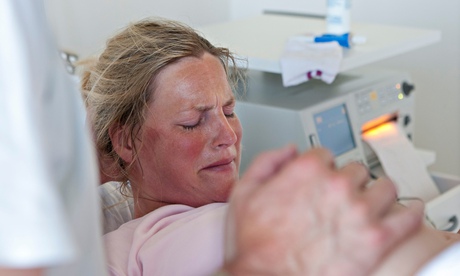
If I say “a woman giving birth”, what is the first image that comes into your head? Give me details: is she upright or on her back, covered or naked, calm or in distress? What are her surroundings? Who attends her and are they touching her? Who is delivering her baby?
In western culture we have a certain set of presumptions about birth that are so tightly set out they would feel restrictive, if only we could notice them. Like a swaddled baby, we feel the comfort of the familiar, and often do not have a reference point for any other way of being. So birth is difficult, painful, to be feared. It is necessary to be on our backs so that our attendants, who understand the process better than we do, can see. It takes place in hospital. There is machinery, a sense of panic. The first hands to touch the baby are those of the expert attendants, for it is they who “deliver” it.
Can birth be different to this? I think so, and my organisation, the Positive Birth Movement, is part of a wave of initiatives that aim to encourage women to reclaim birth; to raise their expectations, learn their rights, and regain confidence in the idea that birth is something the female body was designed to do.
As part of this, we use our active Facebook page to share images of births of all kinds. We make no judgment about women’s choices. We merely present options. It is therefore interesting to see which of these options meet with approval.
Over the weekend, Facebook removed two images from our page and subjected myself and my organisation to a 24-hour ban. This was because, in its words, the images “violated community standards”. Neither image fits the stereotypical picture that most of us have of birth. In the first, a woman kneels: she looks composed, vital and beautiful. The second shows a baby emerging underwater into her mother’s own hands.
You could argue that this is simply about nudity, but I think there’s more to it. Social media reflects our wider culture’s issue, not with naked women, but with naked women who look real and active as opposed to air-brushed and passive. It also reflects millennia of attempts to suppress women’s power, of which childbirth is perhaps the ultimate expression.
Birth is a fundamental feminist issue right now. It belongs to a wave of feminism that focuses on the female body, from #freethenipple, a movement protesting against internet censorship, to challenging victim-blaming when it comes to rape and sexual assault. The female body in childbirth has been sanitised and censored in recent decades: covered by drapes, silenced by drugs, and even devoid of pubic hair. As a result, we have a generation of women who have rarely seen or heard the reality of birth, and who have been told that when you have your baby you must “leave your dignity at the door”. Many women approach birth with fear and, perhaps worse still, often do not realise that they have the right to say no in the birth room just as they do in the bedroom and boardroom.
In both of the banned images, it is the women who are delivering their babies; birth is something they are actively and powerfully doing themselves. They challenge everything many people wrongly assume to be true about childbirth and show the female body naked, shameless, real, capable, useful, active, empowered.
This is why women need to see these images; and this is why they are censored.

